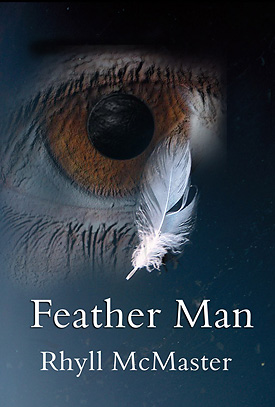
Rhyll McMaster
Brandl & Schlesinger, Australia, 2007
Marion Boyars, UK and USA 2008
|
|
|
Rhyll McMaster, Feather Man, extracts
‘My parents begin one of their muted arguments in the kitchen.
"It’s a catalogue of disasters in this bloody house," my mother whines.
"Argy bargy, argy bargy," my father taunts. "Is that a withering look, Darl? Where’s your sense of humour?"
"You’re not going to make me," my mother says. "You’d better watch out!" I know what follows. "Or there’ll be trouble." A pot and the frying pan (I can tell the difference) clatter. The saucepan cupboard slams shut.
"Make up your mind, Darl," Dad sneers. "Stop beating round the bush." He sniggers. "Don’t hesitate. Are you going to throw it or not?"
I hear my father walk up the hall and open the front door. There is that second of struggle as the door sticks the last inch. I can hear him scuff the frayed and rucked piece of carpet with his shoe. Mum comes rushing after him as if chasing the course of fate, and the dog rushes with her.
"You’d better do something, Darl," she yells. "I’m sick and tired of this. You must be having a nervous breakdown."
The dog barks in confusion at my father. By this time he is halfway down the steep brick stairs. From my bedroom doorway I am just in time to see my mother trip on the rucked carpet and the scuttling dog, and fall down the steps after him.’
(Chapter 22, Tennessee Waltz)
‘I went into the shop and spent a long time deciding what to buy. A big pad about three feet by two. Thick cream paper. Graphite. The yearned-for oil sticks. Pastels, wax and canvas.
I knew what I was going to do. In my mind I called them Ersatz Portraits. Portraits drawn from memory. The subjects, surrounded by items that embodied character, would have words crawling out of their skins. The first one would be the women at work in Waterloo, a group portrait, a Dutch interior. I felt an urge to get started that was so strong that I hopped from foot to foot outside the gallery next door.
I knew what else I was going to do. I was going to start looking after my own interests. Just like Redmond, I was going to work the room.
The heavy gallery door opened. A man stood in the entrance. He smiled at me, amused. "Would you like to come in? There are facilities…"
I shook my head. "No. No, thank you, I’m right. Sorry."
You idiot. What are you saying that for? whispers Christine.
"Really?" He still looked ironic. "Why don’t you. Here, let me take that." And he stepped out to the footpath and took my art supplies from me. Then he turned, went inside and disappeared, leaving the door open.
What’s going on? My mother’s voice is loud in my ear. Then in a frantic rush: Watch what you’re doing. You’ll get it all wrong.
My father’s voice cackles: Stick your head in the lion’s mouth. See how it feels. Go on, Darl. See what he does.
I don’t feel anything, I tell him. I never do.
Then make it up, advises Christine, on her way past. He’s not my type. He’s too old—but anyway…
The man reminded me of a younger version of the actor Curt Jurgens, but more Magyar, with his square head flat at the back and his hair slicked straight back from the temples. His intonations were middle-European, overlaid with precise English, a learned sound.
In front of me the wooden floor of the hallway shone. I could smell bees-wax. Oriental rugs lay as if they had slipped from their frames. On the right was an office and on its inside back wall I could see another door that looked as if it housed the stacks and shelving. He was not in the office. On the left was a large glass double door with brass handles. I could see through to an expansive, daylit gallery, with more beyond. It was empty of people too.’
(Chapter 44, The Gallery)
|

